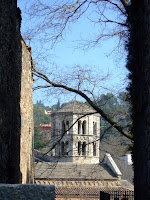
There are only two Grade 1 listed Industrial buildings in South London. One is a very well known, and much photographed, London icon (Tower Bridge) and the other is known to very few people, and given its location, seen and photographed by even fewer.
We had booked a tour of the
Crossness Pumping Station for Sunday afternoon. This was a magnificent Victorian achievement, commissioned after the

year of the ‘Great Stink' (1858) to deal with the problem of raw sewage in the Thames.
It was designed on a large and impressive scale. Not only was the machinery impressive, the building to house the 4 huge pumps, was named the Cathedral in the Marsh.

The Victorians surely knew how to get things done. The station was commissioned in 1865, just 7 years after the ‘stink’ and in only three years, 318 million bricks had been used to make 82 miles of intercept sewers to divert flows from discharging into the Thames and re-route the sewage downstream to Crossness on the

south bank and Abbey Mills on the north.
There, these huge pumps each lifted 100 tonnes of effluent per hour into a reservoir where it was held until the tide began to ebb and the gates were opened to discharge the raw sewage into the Thames.

Following its closure in 1956 it has lain abandoned and vandalized until restoration began in 1985. The restoration is a huge project, where you can see plenty of evidence of before and after and one that will keep the willing enthusiasts busy for years to come.

We intended to catch some of the Chinese New Year's celebrations both on the way in and way home, but managed to time it wrong both ways. However, we did enjoy the sense of humour displayed by the Metropolitan Police as they distributed hundreds of red balloons in honour of the Chinese year of the Pig.


 reported that his Professor said that he did not know if he was awarding a degree to a genius or a lunatic. We made an early start to the day at Parc Guell, which is well towards the lunatic end of the spectrum, and ended with the unfinished Cathedral, which is sheer engineering brilliance.
reported that his Professor said that he did not know if he was awarding a degree to a genius or a lunatic. We made an early start to the day at Parc Guell, which is well towards the lunatic end of the spectrum, and ended with the unfinished Cathedral, which is sheer engineering brilliance.






























